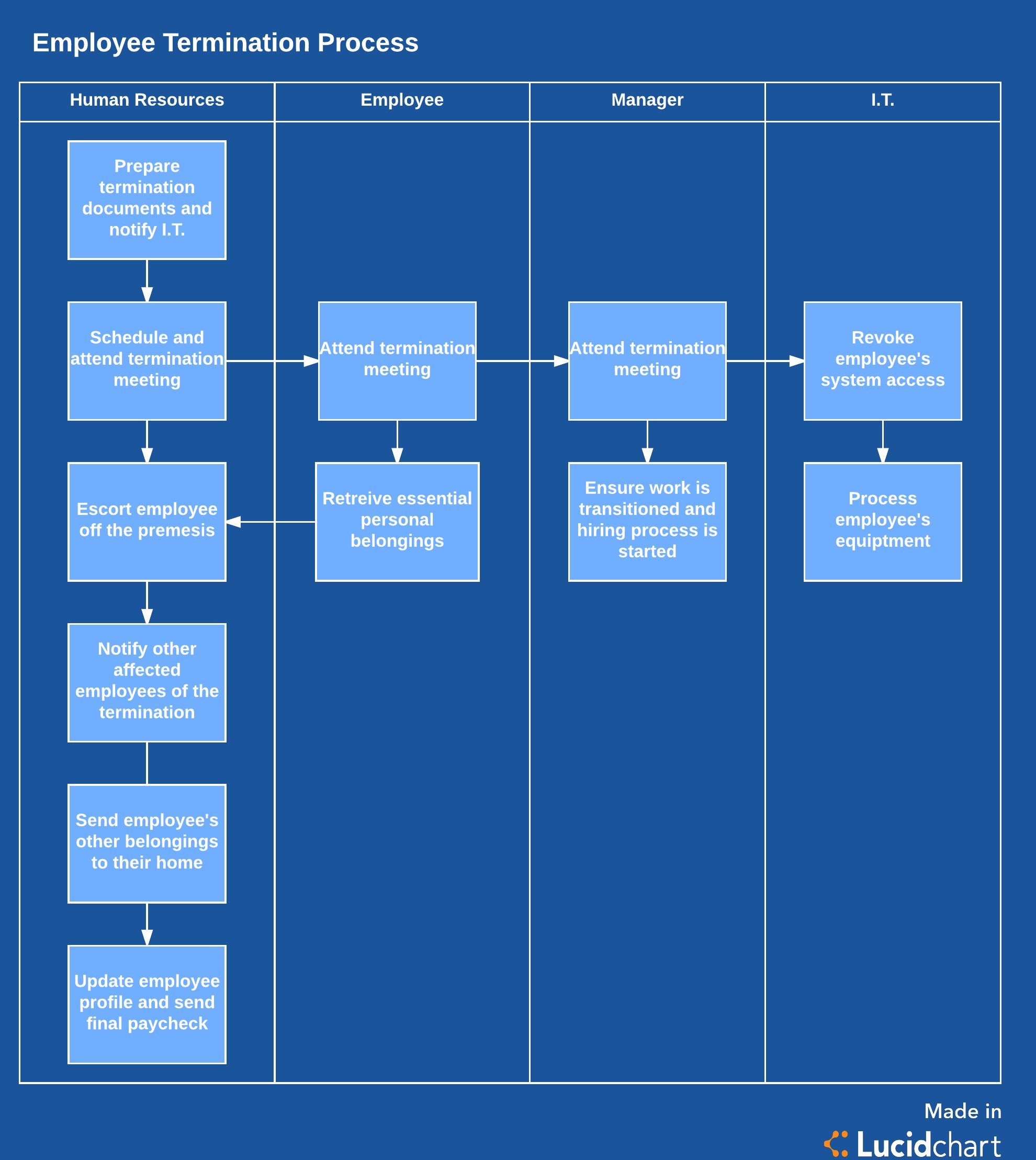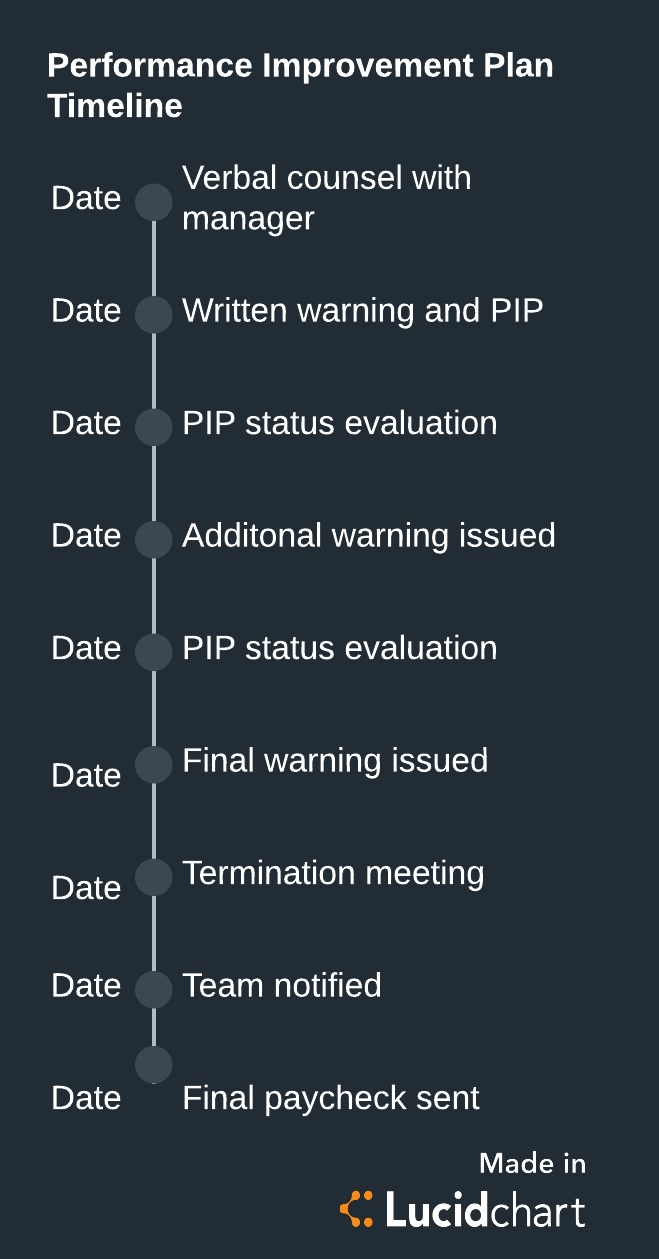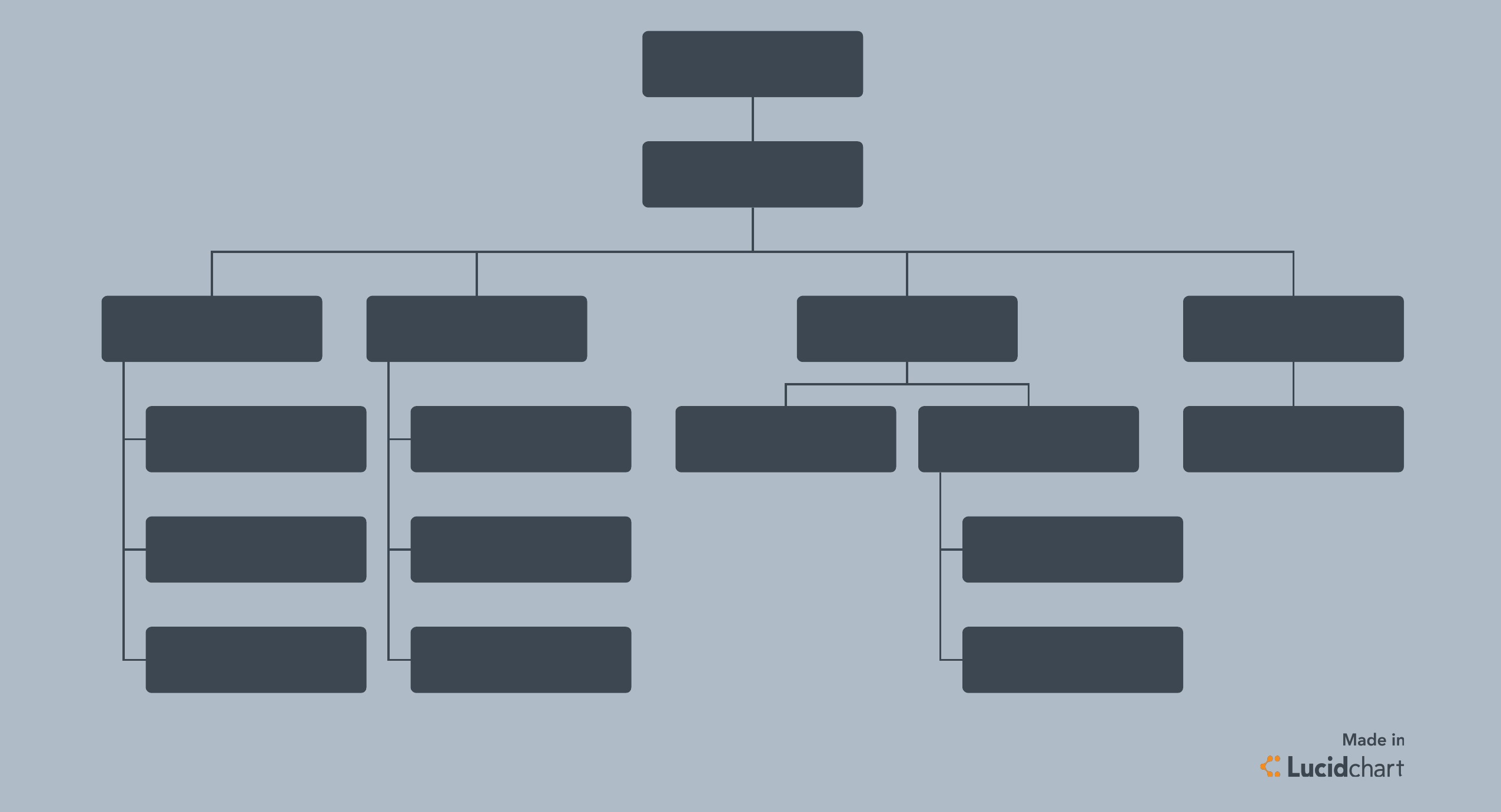
How to Create an Employee Termination Process and Make a Bad Process Better
Lucid Content
Reading time: about 7 min
Topics:
Employee Termination Process
Begin by notifying everyone in your organizational chart who needs to know. Involve HR, IT, and anyone else responsible for signing off on a termination. You may want to notify your legal team as well. Create a companion checklist that you can distribute to the relevant departments to ensure no details get overlooked.
Pop culture makes terminating an employee look simple: just shout “You’re fired!” and storm off. The reality, however, is much more complicated than that. If you want to keep your business running smoothly and safely, you need to develop an employee termination process today.

Why you need an employee termination process
Terminating an employee is almost always unpleasant—it’s often awkward for the individuals involved, it disrupts work, and the infrequency of the situation makes it hard to become practiced.
But termination isn’t just awkward or unsettling; a sloppy termination process can lead to legal liability for the company, too. Saying the wrong thing or sending a final paycheck too late can leave you vulnerable to lawsuits from former employees. Employee termination laws vary by state, and given the time-sensitive nature of some of these laws that govern your business, you can’t afford to wait until you’re firing someone to learn them.
There are other time-sensitive procedures you need to plan in advance as well, like revoking technology permissions. While most employees accept their termination with grace, just one bitter ex-employee with access to important documents can severely damage your business.
All of these difficulties are only made worse when you’re not sure if you’re doing everything correctly. An unclear human resources termination process can lead to additional uncertainty and anxiety.
The solution to these problems? Plan your employee termination process in advance, long before you ever need it. With a plan in place, you won’t have to scramble to make sure things are done appropriately, legally, and safely.
The employee termination process
Before you begin crafting your personal employee termination process, make sure you know some of the most important components. A valuable employee termination process covers what you should do before you terminate anyone, during the termination, and after the terminated employee is gone.
Preventing employee termination
Before you jump to termination, we recommend reviewing this process for improving employee behavior prior to deciding on termination to see if the situation can be avoided:

A few of the things you can do to prevent termination include establishing and documenting guidelines as to what constitutes termination-worthy behavior. For example, you might decide habitual tardiness and failure to follow confidentiality procedures are terminable offenses. You may have to update these guidelines when unexpected scenarios arise.
Make these policies widely available in your employee handbook. By establishing these guidelines, you ensure employees know what you expect of them. These guidelines help prevent the kind of behavior that leads to termination, and they dispel any claims of ignorance.
Moreover, established policies make your position easier. There’s no need to quibble over what is and isn’t a terminable offense if you have decided in advance. That way, you’ll be able to act quickly and decisively. To further simplify this process, break down which offenses merit disciplinary action or a performance improvement plan and which merit immediate termination.
Before you terminate
Once an employee has committed a terminable defense, you have several possible courses of action. If your policy allows, you can create a performance improvement plan or take disciplinary action in the hopes of avoiding termination. In some cases involving a severe offense, though, you may need to terminate the employee immediately.
Whatever course of action you take, document it thoroughly. If you create a performance improvement plan with the employee, write it down. Thorough documentation lets both you and the employee refer to the plan, and it protects the company. Likewise, if you take disciplinary action, record pertinent details.

When you decide to terminate
Begin by notifying everyone in your organizational chart who needs to know. You will typically need to involve HR, IT, and anyone else responsible for signing off on a termination. You may want to notify your legal team as well.

Once relevant parties know about the termination, schedule a meeting with the employee, preferably giving just a few minutes of notice. Late notice doesn’t give the employee time to stew about an upcoming meeting and allows you to be sensitive to the employee’s feelings. It also serves as a security measure to ensure they don’t begin emailing themselves files or deleting them.
Include a witness in the termination meeting (preferably an HR or legal representative) to limit your liability. Keep the meeting short. Briefly explain to the employee why they’re being terminated, but avoid overexplaining, exaggerating, or justifying. It’s helpful to rehearse the explanation beforehand.
Remind the employee of any confidentiality or noncompete agreements. Likewise, let the employee know when they can expect to receive a final paycheck, whether they will be paid for unused vacation hours, and what will happen with any health care benefits. Consider furnishing the employee with a termination letter, as they may need one to collect unemployment benefits.
This meeting can also serve as a brief exit interview. While you’ll likely take a terminated employee’s feedback with a grain of salt, they may provide useful suggestions that can help you avoid future terminations. For example, they might reveal that feelings of exclusion affected their performance, which could encourage you to develop a more inclusive culture. As you accept feedback, make it clear this information does not affect their terminated status.
As this meeting takes place, IT should revoke all computer and data permissions for the terminated employee. You should also have the employee turn over any keys, badges, laptops, phones, or other company property. If they do not have all that equipment with them, make a clear plan to get everything returned as soon as possible, perhaps requiring all company property to be returned before you issue a final paycheck.
At the close of the termination meeting, escort the employee from the building as discreetly as possible, letting them collect only essentials like car keys from their desk. Tell them when they can return to collect other belongings or if you’ll mail their remaining personal effects.
After termination
At this point, you may need to make other employees aware of the termination. Tell only employees affected by the termination. For liability reasons, keep explanations short, simply stating that the former employee no longer works there. Let affected employees know about any transition plans, too, whether that means hiring a replacement, restructuring the team, or taking some other measure.
Follow through on any final obligations to the terminated employee, such as sending their last paycheck or letting them come in after hours to collect their belongings.
Have a policy in place for future interactions with the terminated employee as well. Establish how your company will respond to reference requests, and ensure that, when the time comes, relevant tax documents get sent to the former employee.
Begin with your established guidelines for terminable behavior, with each offense flowing into the appropriate action (performance improvement plan, disciplinary action, or immediate termination). Be sure to include documentation steps in your flowchart. If the problem behavior stops, your process is finished. If not, your chart should flow into what happens when you decide to terminate.
Figure out who needs to be notified in your process, referring to your org chart as necessary. Again, it’s a good idea to include HR, IT, and legal at this point. Branch out your flowchart to include whatever steps these departments need to take, and make these steps specific to your organization. For example, make it clear that IT needs to revoke permissions on your email, chat, project management system, and file sharing service of choice, and list specific company property that needs to be recovered. If a list gets particularly long, use Lucidchart to create a companion checklist that you can distribute to the relevant departments to ensure no details get overlooked.

Returning to your overall process, include termination meeting protocol in your flowchart. Break down the phases of the meeting as needed, and include any steps specific to your company, such as reviewing a nondisclosure or noncompete agreement.
Consult with your legal team to ensure your process falls within legal bounds. Some states, for example, may require final paychecks to be furnished upon termination, whereas others give employers until the next payday. Figure out what laws apply to your company, and include corresponding steps in your flowchart.
Once you’ve laid out the termination meeting steps, create and include policies about what happens after termination, such as when terminated employees can collect their belongings or how you should respond to reference requests.
Consider ending your flowchart with a step for reviewing the employee termination process. This step will encourage you to keep your flowchart up to date and will enable you to fine-tune your process for your company’s specific needs.
Create your employee termination process now
Employee termination will almost always be unpleasant, but a good process can make it easier on everyone. Don’t wait until you need to terminate someone to create your employee termination process—create a process flowchart with Lucidchart today, and enjoy the security of a well-defined protocol.
About Lucidchart
Lucidchart, a cloud-based intelligent diagramming application, is a core component of Lucid Software's Visual Collaboration Suite. This intuitive, cloud-based solution empowers teams to collaborate in real-time to build flowcharts, mockups, UML diagrams, customer journey maps, and more. Lucidchart propels teams forward to build the future faster. Lucid is proud to serve top businesses around the world, including customers such as Google, GE, and NBC Universal, and 99% of the Fortune 500. Lucid partners with industry leaders, including Google, Atlassian, and Microsoft. Since its founding, Lucid has received numerous awards for its products, business, and workplace culture. For more information, visit lucidchart.com.
